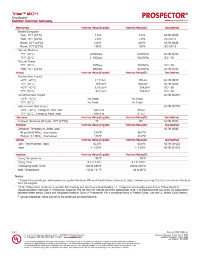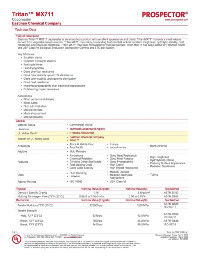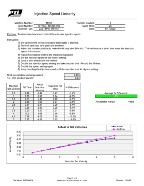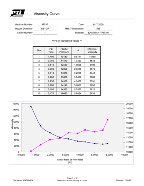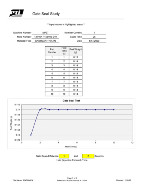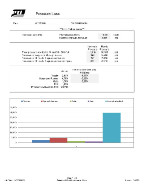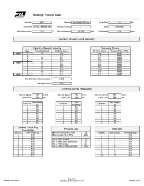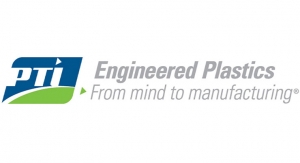By Sean Fenske, Editor-in-Chief
Some component fabrication techniques are viewed by many as more of an art form than a scientific method. In medical device manufacturing, however, where reliability and consistency are paramount, there needs to be the ability to accurately maintain a process, such as molding, to ensure the same results for critical healthcare products.
As more medical manufacturing firms seek data and the incorporation of artificial intelligence in their processes, having suppliers who can accurately measure and prepare for repeatability in output becomes increasingly important. Suppliers who embrace scientific molding can provide measurable data on the moisture level in their resin and the amount of material being used for each shot.
Speaking to the specifics of this technique in the following Q&A is Marjan Panevski, process engineer manager, and Randy Kliemann, process engineer, at PTI Engineered Plastics. They’ve offered insights on the considerations a molder that has embraced scientific molding keeps in mind and provides topics a medical device OEM may want to ask a potential supplier about.
Sean Fenske: Depending on the material being used, what characteristics must be accounted for in developing the molding process?
Marjan Panevski: An important factor would be whether the material is crystalline or amorphous. Crystalline materials have a sharp melting point and an aligned molecule structure that needs to be achieved during the molding process to reflect good part quality. Amorphous materials have a wider range when processing.
Ensure proper melt temperature is achieved in correlation with machine shot capacity used for a molded part and cycle time for selected material. Also mold surface temperature needs to be achieved and maintained to material supplier recommendations.
Many resins have added fillers and additives to help with part release, strength, and overall quality. This is good to know while developing a molding process since some additives might be more sensitive than other materials and might degrade faster.
Fenske: How do you properly store the material?
Panevski: It makes sense to store resin so as to minimize exposure to ambient conditions and maintain a relatively consistent temperature. Resin should be stored in a central location, away from dock doors to avoid constant changes in temperature and moisture levels.
Since resins that arrive at our facility are typically dry, we open only the resin that is needed, one bag or container at a time. After the production run using the resin is complete, the unused material is sealed in bags, barrels, bins, or boxes.
The material’s warehouse storage location should be entered into a computer so it can be located timely the next time it is needed.
Fenske: Can you please explain the material drying process?
Panevski: Resin drying is a crucial part of most molding processes. Desiccant dryers, which absorb moisture, have long been the standard for drying resins, and generally include some configuration of a moisture-removal filter or bed that recycles dry air through the system in a closed loop.
The key metric for effective drying is dewpoint, which equates with ambient moisture. That is, the lower the dewpoint, the less moisture there is in the air inside the dryer. The ideal dewpoint for drying most resins is -40°F. So, a dryer that can maintain a consistently low dewpoint creates an environment that won’t be affected by changes in ambient weather, temperature, or humidity. That’s great for resin drying consistency.
Fenske: How do you ensure the drying process is adequate?
Panevski: The only way to know for certain your resin drying methods are adequate is by testing the material in a moisture analyzer. Our moisture analyzers function as follows: a predetermined amount of resin is placed on a weigh pan in the analyzer, which is located over a heating element. The moisture analyzer lid is the closed and the test sample is weighed. The analyzer element heats to a predetermined temperature. Any moisture in the resin is then extracted, reducing the overall weight on the pan. Once the test sample is no longer losing weight, the test is complete. The moisture content can then be determined as the percentage of the final sample weight divided by the initial test weight.
Moisture analysis is central to knowing if the resin is dried properly. Certain hygroscopic resins such as nylon, PC, and PET have to be dried before processing.
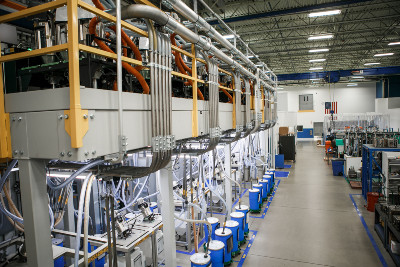
PTI’s Material Drying System
If you want a stable process and parts that function properly, you must monitor the water content of the resin before processing.
Fenske: Are material trials a typical offering and is it a service PTI provides?
Randy Kliemann: PTI has extensive experience molding a wide range of materials, such as PP, PA, POM, ABS, PEI, PEEK, PMMA, and many other engineered materials. Material trials are performed quite often as a service to our customers.
Fenske: In terms of press selection, what considerations must be addressed and what performance characteristics are required?
Kliemann: Size of the tool is the first important factor to consider. It must fit between machine tie bars, have correct thickness to fit between machine platens, and be able open and close safely.
To mold a quality part, machine barrel capacity utilization needs to be from 20% to 80%, or in some instances, from 30% to 70%, when using engineered resins such as PEEK. It is also important to consider if any additional equipment needs to be used with the tool, such as robots, valve gate and core pull devices, air blowing devices, hot runner controllers, high heat mold heaters, etc.
Fenske: Can you please explain what decoupled molding is?
Panevski: Decoupled molding is a system of molding techniques developed to achieve a higher level of accuracy and repeatability in the molding process, as molding conditions such as viscosity (resistance to flow) naturally vary over time. Decoupled molding involves separating the fill and pack stages of the molding process, using machine controls to accomplish the transfer from first stage speed control to second stage pressure. Decoupled molding can further be divided into decoupled I (DI), decoupled II (DII), and decoupled III (DIII) processing techniques.
Fenske: Can you further explain these three processing techniques and also speak more to their relationship to fill/pack/hold?
Panevski: Traditional molding or decoupled I is the less advanced and least consistent method of molding, where the fill and pack stages occur as one. This is an older style of processing, and with current advances in technology, is not utilized today.
Decoupled II molding allows for more control of the molding process. DII divides the molding process into two distinct phases: first stage fill and second stage pack and hold. First stage is filling the part based off a defined shot transfer position. The goal of this stage is to produce a part roughly 98% full (fill-only short shots) with small, visible shorts located at the end of fill. Second stage is the pack/hold phase. It is used to finish mold filling, compensate for part shrinkage, and hold the part with pressure until gate seal is achieved (at which time, the polymer at the gate is frozen and no more plastic is packed into the cavities or flows back out).
Decoupled III, while similar to DII molding, further divides the pack/hold phase into two separate phases. First stage is filling the part to a shot position of roughly an 80% full part. Second stage pack pressure is then utilized to pack the part to a set cavity pressure, utilizing an external transfer trigger (for instance, an RJG cavity pressure sensor in the mold), at a slower injection speed. Finally, the third stage of a DIII process is the hold phase, where hold pressure is utilized to achieve gate seal and prevent material from flowing back out of the mold. This is the most consistent and repeatable of the decoupled molding techniques as the part is consistently packed to a set cavity pressure, regardless of natural viscosity shifts in the material.
Example of SIM Workbook (Click each image to view a larger version.)
Fenske: Once the mold opens, how should the part be handled and what factors impact this?
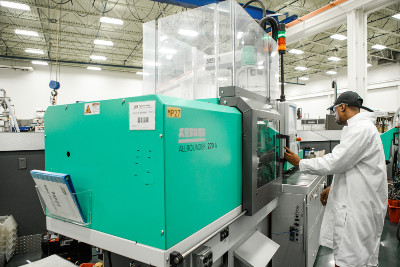
Example of Part Removal
Kliemann: The answer to this question lies largely in the part-geometry/part-print callouts. The part must be removed either by hand or with a robot if:
For the vast majority of parts we manufacture, it is perfectly acceptable to allow them to eject from the mold and fall onto either a part conveyor or part chute. We also have the ability to convert a typical chute to a soft chute to alleviate potential damage to a part.
Click here to learn more about PTI Engineered Plastics >>>>>
Some component fabrication techniques are viewed by many as more of an art form than a scientific method. In medical device manufacturing, however, where reliability and consistency are paramount, there needs to be the ability to accurately maintain a process, such as molding, to ensure the same results for critical healthcare products.
As more medical manufacturing firms seek data and the incorporation of artificial intelligence in their processes, having suppliers who can accurately measure and prepare for repeatability in output becomes increasingly important. Suppliers who embrace scientific molding can provide measurable data on the moisture level in their resin and the amount of material being used for each shot.
Speaking to the specifics of this technique in the following Q&A is Marjan Panevski, process engineer manager, and Randy Kliemann, process engineer, at PTI Engineered Plastics. They’ve offered insights on the considerations a molder that has embraced scientific molding keeps in mind and provides topics a medical device OEM may want to ask a potential supplier about.
Sean Fenske: Depending on the material being used, what characteristics must be accounted for in developing the molding process?
Marjan Panevski: An important factor would be whether the material is crystalline or amorphous. Crystalline materials have a sharp melting point and an aligned molecule structure that needs to be achieved during the molding process to reflect good part quality. Amorphous materials have a wider range when processing.
Ensure proper melt temperature is achieved in correlation with machine shot capacity used for a molded part and cycle time for selected material. Also mold surface temperature needs to be achieved and maintained to material supplier recommendations.
Many resins have added fillers and additives to help with part release, strength, and overall quality. This is good to know while developing a molding process since some additives might be more sensitive than other materials and might degrade faster.
Fenske: How do you properly store the material?
Panevski: It makes sense to store resin so as to minimize exposure to ambient conditions and maintain a relatively consistent temperature. Resin should be stored in a central location, away from dock doors to avoid constant changes in temperature and moisture levels.
Since resins that arrive at our facility are typically dry, we open only the resin that is needed, one bag or container at a time. After the production run using the resin is complete, the unused material is sealed in bags, barrels, bins, or boxes.
The material’s warehouse storage location should be entered into a computer so it can be located timely the next time it is needed.
Fenske: Can you please explain the material drying process?
Panevski: Resin drying is a crucial part of most molding processes. Desiccant dryers, which absorb moisture, have long been the standard for drying resins, and generally include some configuration of a moisture-removal filter or bed that recycles dry air through the system in a closed loop.
The key metric for effective drying is dewpoint, which equates with ambient moisture. That is, the lower the dewpoint, the less moisture there is in the air inside the dryer. The ideal dewpoint for drying most resins is -40°F. So, a dryer that can maintain a consistently low dewpoint creates an environment that won’t be affected by changes in ambient weather, temperature, or humidity. That’s great for resin drying consistency.
Fenske: How do you ensure the drying process is adequate?
Panevski: The only way to know for certain your resin drying methods are adequate is by testing the material in a moisture analyzer. Our moisture analyzers function as follows: a predetermined amount of resin is placed on a weigh pan in the analyzer, which is located over a heating element. The moisture analyzer lid is the closed and the test sample is weighed. The analyzer element heats to a predetermined temperature. Any moisture in the resin is then extracted, reducing the overall weight on the pan. Once the test sample is no longer losing weight, the test is complete. The moisture content can then be determined as the percentage of the final sample weight divided by the initial test weight.
Moisture analysis is central to knowing if the resin is dried properly. Certain hygroscopic resins such as nylon, PC, and PET have to be dried before processing.

PTI’s Material Drying System
Fenske: Are material trials a typical offering and is it a service PTI provides?
Randy Kliemann: PTI has extensive experience molding a wide range of materials, such as PP, PA, POM, ABS, PEI, PEEK, PMMA, and many other engineered materials. Material trials are performed quite often as a service to our customers.
Fenske: In terms of press selection, what considerations must be addressed and what performance characteristics are required?
Kliemann: Size of the tool is the first important factor to consider. It must fit between machine tie bars, have correct thickness to fit between machine platens, and be able open and close safely.
To mold a quality part, machine barrel capacity utilization needs to be from 20% to 80%, or in some instances, from 30% to 70%, when using engineered resins such as PEEK. It is also important to consider if any additional equipment needs to be used with the tool, such as robots, valve gate and core pull devices, air blowing devices, hot runner controllers, high heat mold heaters, etc.
Fenske: Can you please explain what decoupled molding is?
Panevski: Decoupled molding is a system of molding techniques developed to achieve a higher level of accuracy and repeatability in the molding process, as molding conditions such as viscosity (resistance to flow) naturally vary over time. Decoupled molding involves separating the fill and pack stages of the molding process, using machine controls to accomplish the transfer from first stage speed control to second stage pressure. Decoupled molding can further be divided into decoupled I (DI), decoupled II (DII), and decoupled III (DIII) processing techniques.
Fenske: Can you further explain these three processing techniques and also speak more to their relationship to fill/pack/hold?
Panevski: Traditional molding or decoupled I is the less advanced and least consistent method of molding, where the fill and pack stages occur as one. This is an older style of processing, and with current advances in technology, is not utilized today.
Decoupled II molding allows for more control of the molding process. DII divides the molding process into two distinct phases: first stage fill and second stage pack and hold. First stage is filling the part based off a defined shot transfer position. The goal of this stage is to produce a part roughly 98% full (fill-only short shots) with small, visible shorts located at the end of fill. Second stage is the pack/hold phase. It is used to finish mold filling, compensate for part shrinkage, and hold the part with pressure until gate seal is achieved (at which time, the polymer at the gate is frozen and no more plastic is packed into the cavities or flows back out).
Decoupled III, while similar to DII molding, further divides the pack/hold phase into two separate phases. First stage is filling the part to a shot position of roughly an 80% full part. Second stage pack pressure is then utilized to pack the part to a set cavity pressure, utilizing an external transfer trigger (for instance, an RJG cavity pressure sensor in the mold), at a slower injection speed. Finally, the third stage of a DIII process is the hold phase, where hold pressure is utilized to achieve gate seal and prevent material from flowing back out of the mold. This is the most consistent and repeatable of the decoupled molding techniques as the part is consistently packed to a set cavity pressure, regardless of natural viscosity shifts in the material.
Example of SIM Workbook (Click each image to view a larger version.)
Fenske: Once the mold opens, how should the part be handled and what factors impact this?

Example of Part Removal
- There are sharp edges, posts, legs, or molded-in inserts that can be distorted upon ejection.
- There are specific part surface requirements, like a polished surface or texturing.
- The part is manufactured with hand loads.
For the vast majority of parts we manufacture, it is perfectly acceptable to allow them to eject from the mold and fall onto either a part conveyor or part chute. We also have the ability to convert a typical chute to a soft chute to alleviate potential damage to a part.
Click here to learn more about PTI Engineered Plastics >>>>>


